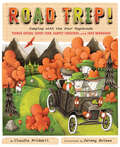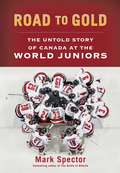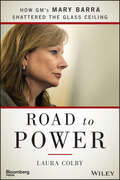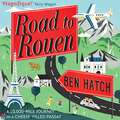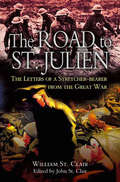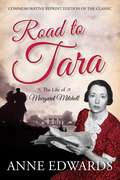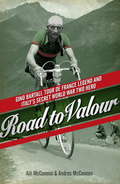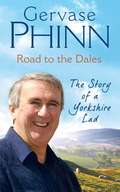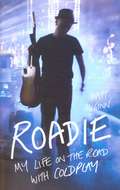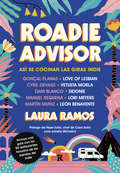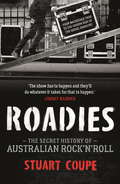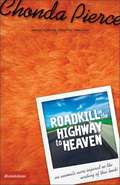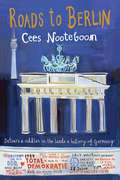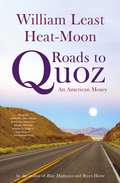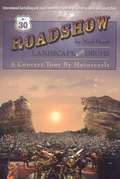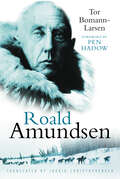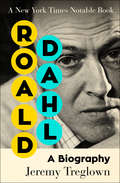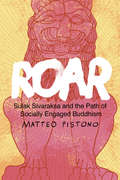- Table View
- List View
Road Trip!: Camping with the Four Vagabonds: Thomas Edison, Henry Ford, Harvey Firestone, and John Burroughs
by Claudia FriddellJoin Thomas Edison, Henry Ford, Harvey Firestone, and John Burroughs on their pioneering camping trips during the early 1900s in this energetic and entertaining nonfiction picture-book adventure.After years of inventing things that other people needed, Thomas Edison and Henry Ford realized there was something they needed—a vacation! So, the famous inventors packed up Ford's Model T and invited their good friends Harvey Firestone and John Burroughs to join them as "the Four Vagabonds" hit America's back roads to enjoy the country's natural beauty, fireside chats, and frolicking fun with friends—all while inspiring future generations to invent camping adventures of their own.&“Buckle yourself in as Claudia Friddell and Jeremy Holmes take you on a fun, creative, and certainly unique road trip with America&’s most famous vagabonds—Thomas Edison, Henry Ford, Harvey Firestone, and John Burroughs. The colorful and spirited illustrations, the stories of the Vagabond&’s bivouacking travels and campsite escapades, and the well-researched bibliography makes Road Trip! a great addition to any child&’s library!&” —Matt Andres, curatorial registrar, Edison and Ford Winter Estates
Road to Gold: The Untold Story of Canada at the World Juniors
by Mark SpectorFrom bestselling author Mark Spector comes the behind-the-scenes story of the Canadian World Junior program&’s journey from obscurity to the international powerhouse that it is today.On the world junior hockey stage today, Canada is known as the team to beat. They hold the record for the most gold medals won (seventeen since the tournament&’s inception), their games draws millions of fans each year, and the tournament serves as a showcase for each year&’s best talent. But things weren&’t always so rosy. For years, Canada languished in obscurity at the World Juniors. Wearing the red-and-white wasn&’t a mark of honour but merely a sideshow to the players, owners resented the interruption to their league operations, and Canada was an afterthought at the tournament. Canada was supposed to be better at hockey than any nation on earth—how could the team languish in such obscurity? So, the team set out on a reclamation mission. The Program of Excellence was born, and with it, a new hope for hockey&’s future in Canada. No more would Canada be content with merely showing up. Instead, each year, the country would send its best talent—from Gretzky to Lemieux to Crosby to McDavid—to reclaim its spot at the top of the hockey world. Tracing the owner disputes, off-ice antics, and riveting on-ice action of nearly forty years at the World Juniors—and full of inside stories from hockey greats—this is hockey history as you&’ve never seen it before. Funny, smart, and clear-eyed, Mark Spector traces the remarkable rise of the Canadian World Junior program and shows how the World Juniors created not just a new team, but a new dream for the sport.
Road to Power
by Laura ColbyFollow a pioneer's journey from factory floor to CEO Road to Power is the story of how Mary Barra droveherself to the pinnacle of a company that steers the nation'swealth. Beginning as a rare female electrical engineer and daughterof a General Motors die maker, Barra spent more than thirty yearsbuilding her career before becoming the first woman to ever lead aglobal automaker. With $155 billion in sales and 200,000 employees,GM is widely considered to be a proxy for the U.S. economy, makingBarra's position arguably the most important corporate role a womanhas ever held. This book describes the personal character, choices,and leadership style that enabled her to break through the glassceiling.When 52-year-old Mary Barra was named CEO of General Motors in2013, only people outside of the company were surprised. She haddone everything from working on the factory floor to overseeingmanufacturing, from improving union relations to paring downbureaucracy, and from running human resources to helping drag thecompany back from its 2009 bankruptcy. This book details each stepof her career, and the lessons she learned along the way.Learn how Mary Barra's willingness to take on diverseassignments helped steer her career trajectoryExamine the fine details of Barra's management style and herability to relate to colleaguesDiscover the qualities and experiences Barra had that drove herto lead this male-dominated professionStudy the valuable lessons Barra learned at each stage in herprofessional life, and why they stuck with her throughout herjourney to the topBarra is most certainly a pioneer for women in business, butshe's also a living lesson as to how far the right outlook, skills,and drive can take you in your career. Road to Powerexplores the talent and the mindset that got her all the way to thetop.
Road to Rouen
by Ben HatchFrom the bestselling author of ARE WE NEARLY THERE YET? (Radio 2 Book of the Year & voted Amazon Customers' Fave Kindle Read 2011) comes a new hilarious and touching story of travel chaos.Chosen as one of Amazon's Best Kindle Books of 2013 Ben Hatch is on the road again. Commissioned to write a guidebook about France (despite not speaking any French) he sets off with visions of relaxing chateaux and refined dining. Ten thousand miles later his family's been attacked by a donkey, had a run-in with a death-cult and, after a near drowning and a calamitous wedding experience involving a British spy, his own marriage is in jeopardy. A combination of obsessions about mosquitoes, French gravel and vegetable theme parks mean it's a bumpy ride as Ben takes a stand against tyrannical French pool attendants, finds himself running with the bulls in Pamplona and almost starring in a snuff movie after a near fatal decision to climb into a millionaire's Chevrolet Blazer.Funny and poignant, Road to Rouen asks important questions about life, marriage and whether it's ever acceptable to tape baguette to your children's legs to smuggle lunch into Disneyland Paris.
Road to Rouen
by Ben HatchFrom the bestselling author of ARE WE NEARLY THERE YET? (Radio 2 Book of the Year & voted Amazon Customers' Fave Kindle Read 2011) comes a new hilarious and touching story of travel chaos.Chosen as one of Amazon's Best Kindle Books of 2013 Ben Hatch is on the road again. Commissioned to write a guidebook about France (despite not speaking any French) he sets off with visions of relaxing chateaux and refined dining. Ten thousand miles later his family's been attacked by a donkey, had a run-in with a death-cult and, after a near drowning and a calamitous wedding experience involving a British spy, his own marriage is in jeopardy. A combination of obsessions about mosquitoes, French gravel and vegetable theme parks mean it's a bumpy ride as Ben takes a stand against tyrannical French pool attendants, finds himself running with the bulls in Pamplona and almost starring in a snuff movie after a near fatal decision to climb into a millionaire's Chevrolet Blazer.Funny and poignant, Road to Rouen asks important questions about life, marriage and whether it's ever acceptable to tape baguette to your children's legs to smuggle lunch into Disneyland Paris.
Road to Rouen
by Ben HatchBen Hatch is on the road again. Commissioned to write a guidebook about France (despite not speaking any French) he sets off with visions of relaxing chateaux and refined dining. Ten thousand miles later his family's been attacked by a donkey, had a run-in with a death-culti and, after a near drowning and a calamitous wedding experience involving a British spy, his own marriage is in jeopardy. A combination of obsessions about mosquitoes, French gravel and vegetable theme parks mean it's a bumpy ride as Ben takes a stand against tyrannical French pool attendants, finds himself running with the bulls in Pamplona and almost starring in a snuff movie after a near fatal decision to climb into a millionaire's Chevrolet Blazer.Funny and poignant, Road to Rouen asks important questions about life, marriage and whether it's ever acceptable to tape baguette to your children's legs to smuggle lunch into Disneyland Paris.(P)2013 Headline Digital
Road to St. Julien: The Letters of a Stretcher-Bearer of the Great War
by John St. ClairWilliam St Clair is perhaps the only soldier to have left a continuous account of his experiences day by day from the moment of joining up in 1914, through the years of horror in the trenches, to the march into Germany in 1919 and the long aftermath of trying to make sense of what had happened. A private in the medical corps, St Clair wrote daily letters, sometimes more, to his future wife Jane. Often scribbled under fire, and sent in the green envelopes that were exempt from censorship, they tell of the famous battles of Loos, the Somme, and Passchendaele, as they happened, with excruciating vividness. They speak too of aspirations, of conversations, of literature, and of love.Published for the first time, these raw, truthful, and deeply moving. letters give us what we have not properly had before, the voice of an ordinary soldier who is also a wonderful writer. The book takes its title from the village of St Julien in Flanders, where, in a captured German pill box, the mind of young soldier was transformed, an event that he later turned into an award-winning play.
Road to Tara: The Life of Margaret Mitchell
by Anne Edwards[from inside flaps] "Torn between a desire to be a part of the rigid Southern social structure and a compulsion to scorn it, Peggy Mitchell grew up something of an outcast. Only after the publication of Gone with the Wind, which she reluctantly relinquished into the hands of a Macmillan editor, did Peggy's fame elevate her above her Atlanta peers. And fame became, in the end, more of a burden than a joy to her. In this fascinating biography, Anne Edwards gets to the heart of the tiny woman who created a legend and, in so doing, became something of a legend herself. The author draws parallels between people Peggy Mitchell actually knew and the characters in her best-seller. We learn that Gone with the Wind, novel and movie, is the culminating triumph of an otherwise tragic life."
Road to Tara: The Life of Margaret Mitchell
by Anne EdwardsMargaret Mitchell was as complex and compelling as her legendary heroine, Scarlett O&’Hara, and her story is as dramatic as anything out of her own imagination—indeed, it is the basis for the legend she created. Gone With the Wind took the American reading public by storm and went on to become the most popular motion picture of all time. It was a phenomenon whose success has never been equaled—and it shattered Margaret Mitchell&’s private life. In this commemorative reprint of Road to Tara, Anne Edwards tells the real story of Margaret Mitchell and the extraordinary novel that has become part of our heritage.
Road to Valor: A True Story of WWII Italy, the Nazis, and the Cyclist Who Inspired a Nation
by Aili McConnon Andres McConnonRoad to Valor is the inspiring, against-the-odds story of Gino Bartali, the cyclist who made the greatest comeback in Tour de France history and secretly aided the Italian resistance during World War II. Gino Bartali is best known as an Italian cycling legend: the man who not only won the Tour de France twice, but also holds the record for the longest time span between victories. During the ten years that separated his hard-won triumphs, his actions, both on and off the racecourse, ensured him a permanent place in Italian hearts and minds. In Road to Valor, Aili and Andres McConnon chronicle Bartali’s journey, starting in impoverished rural Tuscany where a scrawny, mischievous boy painstakingly saves his money to buy a bicycle and before long, is racking up wins throughout the country. At the age of 24, he stuns the world by winning the Tour de France and becomes an international sports icon. But Mussolini’s Fascists try to hijack his victory for propaganda purposes, derailing Bartali’s career, and as the Nazis occupy Italy, Bartali undertakes secret and dangerous activities to help those being targeted. He shelters a family of Jews in an apartment he financed with his cycling winnings and is able to smuggle counterfeit identity documents hidden in his bicycle past Fascist and Nazi checkpoints because the soldiers recognize him as a national hero in training. After the grueling wartime years, Bartali fights to rebuild his career as Italy emerges from the rubble. In 1948, the stakes are raised when midway through the Tour de France, an assassination attempt in Rome sparks nationwide political protests and riots. Despite numerous setbacks and a legendary snowstorm in the Alps, the chain-smoking, Chianti-loving, 34-year-old underdog comes back and wins the most difficult endurance competition on earth. Bartali’s inspiring performance helps unite his fractured homeland and restore pride and spirit to a country still reeling from war and despair. Set in Italy and France against the turbulent backdrop of an unforgiving sport and threatening politics, Road to Valor is the breathtaking account of one man’s unsung heroism and his resilience in the face of adversity. Based on nearly ten years of research in Italy, France, and Israel, including interviews with Bartali’s family, former teammates, a Holocaust survivor Bartali saved, and many others, Road to Valor is the first book ever written about Bartali in English and the only book written in any language to fully explore the scope of Bartali’s wartime work. An epic tale of courage, comeback, and redemption, it is the untold story of one of the greatest athletes of the twentieth century.
Road to Valour: Gino Bartali – Tour de France Legend and World War Two Hero
by Aili McConnon Andres McConnonAn Italian SCHINDLER'S LIST, this is the inspirational story of Gino Bartali, who made the greatest comeback in Tour de France history and secretly aided the Italian Resistance during the Second World War.ROAD TO VALOUR is the inspiring, against-the-odds story of Gino Bartali, the cyclist who made the greatest comeback in Tour de France history and still holds the record for the longest gap between victories. Yet it was his actions during the Second World War, when he secretly aided the Resistance, rather than his remarkable exploits on a bike, that truly cemented his place in the hearts and minds of the Italian people.Based on nearly ten years of research, and including fascinating new interviews, this is the only book written that fully explores the scope of Bartali's wartime work. A breathtaking account of one man's unsung heroism and his resilience in the face of adversity, this is an epic tale of courage, comeback and redemption, and the untold story of one of the greatest athletes of the twentieth century.
Road to the Dales: The Story of a Yorkshire Lad
by Gervase PhinnA unique look into the childhood experiences of Gervase Phinn in Road to the Dales.Gervase tells of a life full of happiness, conversation, music and books shared with his three siblings, mother and father. This book is a snapshot of growing up in Yorkshire in the 1950s - reminisce with Gervase, and share in his personal journey - of school days and holidays as well as his tentative steps into the adult world. Devour numerous uproarious stories including the incident involving a broken greenhouse, crashing his brother's newly restored bike as well as secrets about his first dates, adventures at summer camp, family trips to Blackpool and many other captivating tales.With a wicked ear for the comical, and a sharp eye for detail, Road to the Dales visits poignant moments, significant events and precious memories from a boy called Gervase Phinn.Gervase Phinn is an author and educator from Rotherham who, after teaching for fourteen years in a variety of schools, moved to North Yorkshire to be a school inspector. He has written autobiographies, novels, plays, collections of poetry and stories, as well as a number of books about education. He holds five fellowships, honorary doctorates from Hull, Leicester and Sheffield Hallam universities, and is a patron of a number of children's charities and organizations. He is married with four adult children. His books include The Other Side of the Dale, Over Hill and Dale, Head Over Heels in the Dales,The Heart of the Dales, Up and Down in the Dales and Trouble at the Little Village School.
Roadie: My Life on the Road with Coldplay
by Matt McGinnAs Coldplay moves from club gigs to arenas and stadiums worldwide, Matt goes with them; faking it as a band member on U.S. talk shows, flirting with Kylie, saving a life on a French motorway, and even pitching in with the odd guitar riff in the studio. Tales of hurricanes and heat waves, helicopter chases and private jets, plectrum hunters and projectiles all come together.
Roadieadvisor: Así se cocinan las giras indie
by Laura RamosLove of Lesbian, Vetusta Morla, Sidonie, Lori Meyers y León Benavente. Las cinco bandas indie más populares de España revelan los secretos de sus giras de la mano de sus Tour Managers Love of Lesbian, Vetusta Morla, Sidonie, Lori Meyers y León Benavente. Cinco iconos del indie español son los protagonistas de este libro gracias a las confidencias de sus Tours Managers, los encargados de organizar sus giras. Son la cara oculta de unas bandas que mueven masas aquí y al otro lado del Atlántico, pero desde la sombra lo controlan y lo saben todo: sus rituales antes de un concierto, lo que no puede faltar en el camerino, miedos a volar y manías en la carretera, y lo más importante: dónde y cómo comer. Recorremos con ellos un mapa de carreteras del indie nacional que hará las veces de guía gastronómica y de retrato confidencial de algunos de los artistas más destacados del panorama español.
Roadies: The Secret History of Australian Rock'n'Roll
by Stuart CoupeThis is your backstage pass to the hidden side of the music industry - the tantrums, the fights, the tensions, the indulgence, the sex, the alcohol, the drugs. The roadies see it all, and now they are sharing their secrets. Roadies are the unsung heroes of the Australian music industry. They unload the PAs and equipment, they set it all up, they make sure everything is running smoothly before, during and after the gigs. Then they pack everything up in the middle of the night, put it in the back of the truck and hit the road to another town - to do it all over again. They know everything about the pre- and post-show excesses. They bear witness to overdoses, the groupies, the obsessive fans. They are part of - and often organise - all the craziness that goes on behind the scenes of the concerts and pub gigs you go to. From The Rolling Stones to AC/DC, Bob Marley to Courtney Love, Sherbet to The Ted Mulry Gang, INXS to Blondie - these guys have seen it all. And now they're stepping onto the stage and talking.The Roadies' Creed: If it's wet, drink it. If it's dry, smoke it. If it moves, **** it. If it doesn't move, throw it in the back of the truck.'Fabulous . . . a bold portrait' SYDNEY MORNING HERALD on Stuart Coupe's GUDINSKI
Roadkill on the Highway to Heaven
by Chonda PierceChristian comedian Chonda Pierce takes a look at life on the road as she travels around the world. Her stories will make you laugh, cry, and always point to Christ.
Roads to Berlin
by Laura Watkinson Cees NooteboomRoads to Berlin maps the changing landscape of post-World-War-II Germany, from the period before the fall of the Berlin Wall to the present. Written and updated over the course of several decades, an eyewitness account of the pivotal events of 1989 gives way to a perceptive appreciation of its difficult passage to reunification.Nooteboom's writings on politics, people, architecture, and culture are as digressive as they are eloquent; his innate curiosity takes him through the landscapes of Heine and Goethe, steeped in Romanticism and mythology, and to Germany's baroque cities. With an outsider's objectivity he has crafted an intimate portrait of the country to its present day.From the Hardcover edition.
Roads to Quoz: An American Mosey
by William Least Heat-MoonAbout a quarter century ago, a previously unknown writer named William Least Heat-Moon wrote a book called Blue Highways. Acclaimed as a classic, it was a travel book like no other. Quirky, discursive, endlessly curious, Heat-Moon had embarked on an American journey off the beaten path. Sticking to the small places via the small roads--those colored blue on maps--he uncovered a nation deep in character, story, and charm. Now, for the first time since Blue Highways, Heat-Moon is back on the backroads. ROADS TO QUOZ is his lyrical, funny, and touching account of a series of American journeys into small-town America.
Roadshow, A Landscape With Drums
by Neil Peart"In this unique travelogue, Peart leverages his considerable literary penmanship to describe the joys and rigors of a rock tour as well as his impressions of the politics, social mores, and cultural heterogeneity he encounters across states and nations. As Peart travels for his art, he perfectly describes the art of travel."
Roadside: My Journey to Iraq and the Long Road Home
by Dylan Park-PettifordA military memoir by a biracial child of refugees and survivors, Roadside is about life and death, about family lost and gained, and about America, as a dream and a reality. It's about the roads one takes to leave home and find it again. As a half-Black, half-Korean kid in Campbell, California, Dylan Park-Pettiford never really fit in, so he and his little brother Rory became joined at the hip. But after the terror attacks of September 11, 2001, swept up in patriotism, Dylan enlisted in the US Air Force and was sent to Iraq, and the brothers were separated. There Dylan's days alternated between boredom and terror, and rare moments of levity and learning came thanks to an Iraqi boy named Brahim. Like Rory, Brahim was wise beyond his years, and he and Dylan bonded as much over rap music as about life. Over the following year, Dylan would bring Brahim food and toiletries to keep him going; Brahim would bring intel to keep Dylan and his friends alive. When they said goodbye at the end of Dylan's tour of duty, he knew it was for the last time. Or was it? Dylan returned to a world that had moved on without him. He would go through a soul-crushing divorce, a bout of homelessness, and struggles with prescription drugs, alcohol, and his own mental health. Eventually, he caught a few breaks and overcame the odds—until the violence Dylan thought he'd left in the Middle East followed him home.Just when his life was at its darkest, fate intervened again, but this time to orchestrate an impossible reunion. In a world marred by a seemingly endless wave of negativity, this story of love, loss, and brotherhood may offer a faint glimmer of hope as we face an uncertain future.
Roald Amundsen
by Tor Bomann-Larsen Pen Hadow Ingrid ChristophersonOn 14 December 1911, the Norwegian explorer Roald Amundsen and his team became the first human beings to reach the South Pole, just over a month before Robert Falcon Scott's ill-fated Terra Nova expedition. He had already led the first expedition to traverse the North West Passage, and would go on to lead the first successful attempt to cross the Arctic by air (perhaps even becoming the first to reach the North Pole, according to some interpretations). Yet his personal life was messy to say the least, with a string of mistresses, including Eskimo girls he brought back to Norway, and a poisonous relationship with his brother. He disappeared in 1928 while taking part in an airborne rescue mission in the Arctic; his body was never found. Tor Bomann-Larsen's account of his life is the only full biography of Amundsen to be published in English.
Roald Dahl: A Biography
by Jeremy TreglownA New York Times Notable Book: A revealing look at the famous twentieth-century children&’s author who brought us The BFG and Charlie and the Chocolate Factory. Few writers have had the enduring cultural influence of Roald Dahl, who inspired generations of loyal readers. Acclaimed biographer Jeremy Treglown cuts no corners in humanizing this longstanding immortal of juvenile fiction. Roald Dahl explores this master of children&’s literature from childhood—focusing a tight lens on the relationship between Dahl and his mother, who lovingly referred to him as &“Apple&”—through to his death. Treglown deftly navigates Dahl&’s time as a fighter pilot in the Royal Air Force, exploring how the experience transformed many of the beliefs that influenced the English writer&’s work, including The Gremlins, which was commissioned by Walt Disney. A former editor of the Times Literary Supplement, Treglown discusses many of Dahl&’s most famous works, such as James and the Giant Peach and Fantastic Mr. Fox, while also delving into his marriage to actress Patricia Neal, combing through letters and archives to show a man who could be both comic and vitriolic, thoughtful yet manipulative and irascible. Treglown highlights many of Dahl&’s literary achievements as well as his breakdowns and shortcomings, presenting a very personal and telling picture of the author and the inner turmoil that crippled him. Separating the man from the myth, Treglown&’s frank, intimate portrait of Dahl illuminates the contradictions within the mind of this beloved author, a man who could be both a monster and a hero. It is required reading for book lovers and film buffs alike.
Roald Dahl: Teller of the Unexpected: A Biography
by Matthew DennisonFrom one of our finest literary biographers comes a brilliant biography of Roald Dahl: the much-loved author and creator of countless iconic literary characters.Roald Dahl was one of the world's greatest storytellers. He conceived his vocation as as that of any fearless explorer and, in his writing for children, he was able to tap into a child's viewpoint throughout his life. He crafted tales that were exotic in scenario, frequently invested with a moral, and filled with vibrant characters that endure in public imagination to the present day. In this brand-new biography, Matthew Dennison re-evaluates the traditional narrative surrounding Dahl—that of school sporting hero, daredevil pilot, and wartime spy-turned-author—and examines surviving primary resources as well as Dahl's extensive literary output to tell the story of a man who identified as a rule-breaker, an iconoclast, and a romantic—both insider and outsider, war hero and child's friend.
Roar: Sulak Sivaraksa and the Path of Socially Engaged Buddhism
by Matteo PistonoThe captivating life story of a renowned Siamese Buddhist activist, critic, and indomitable defender of the disenfranchisedMatteo Pistono’s deft prose weaves together the story of Sulak Sivaraksa’s years of social-justice work and his tireless campaigns to effect change. As a seminal figure in the world of socially engaged spirituality, Sulak has given us a blueprint for peaceful, nonviolent activism in the twenty-first century. More than forty vintage photos illustrate both his life and a turbulent period in Thailand’s history.
Roaring Back: The Fall and Rise of Tiger Woods
by Curt SampsonThe incredible true story of Tiger Woods&’s dramatic comeback following his humbling and very public personal, physical, and professional setbacks. One publicly imploded marriage. Two car accidents. Eight surgeries. And now, a miracle of hard work and storied talent: five Masters wins. Once hailed as &“the greatest closer in history&” before he fell further than any beloved athlete in America&’s memory, Tiger swung at the world&’s wildest expectations and beat the skeptics with his April 2019 Masters championship. Roaring Back traces his road to Augusta and the improbable, phenomenal comeback of one of the greatest golfers in history.New York Times–bestselling author Curt Sampson details the highs and lows of Woods&’s career in three gripping acts. From his startling loss at the 2009 PGA Championship, detrimental obsession with his swing, and that infamous night involving an ex-wife and a nine-iron…to adoring fans and lucrative sponsors turning their backs, exclusive interviews with past instructors and PGA tour peers, and an arrest complete with a toxicology report . . . finally to Tiger coming from behind for his fifth green jacket as the crowd rumbled in Georgia, and how his comeback rivals those of the most dramatic in his sport. Sampson also places Woods&’s defeats and triumphs in the context of historic comebacks by other notable golfers like Ben Hogan, Skip Alexander, Aaron Silton, and Charlie Beljan, finding the forty-three-year-old alone on the green for his trajectory of victory against all odds. As this enthralling book reveals, Tiger never doubted the perseverance of the winner in the mirror.&“Sampson admirably details all the highs and lows.&” —Jim Nantz, CBS Sports
